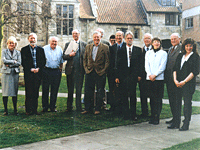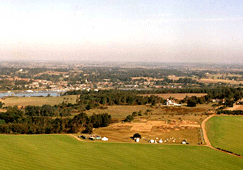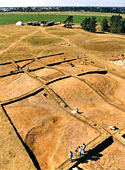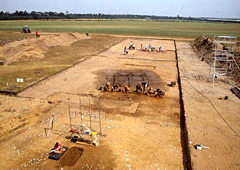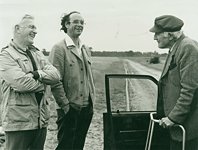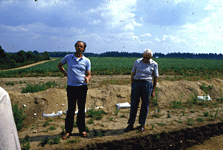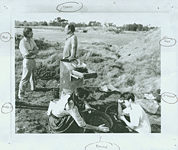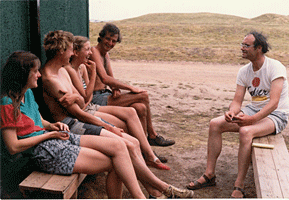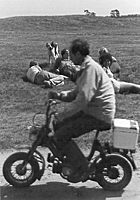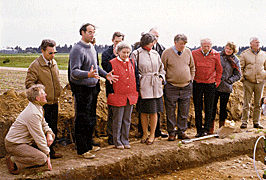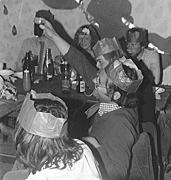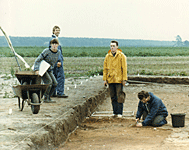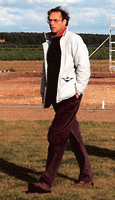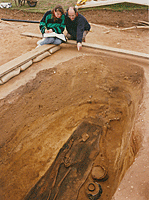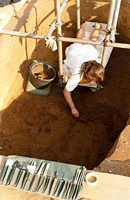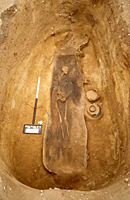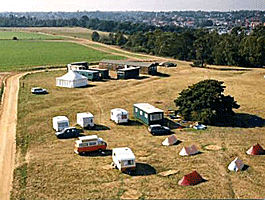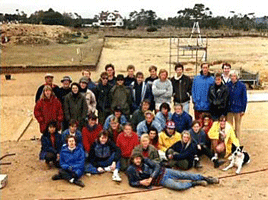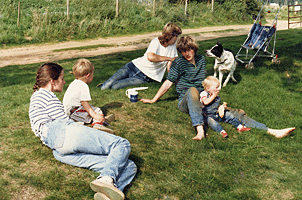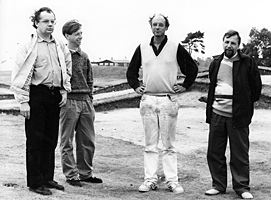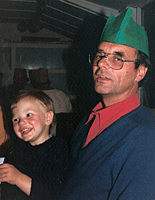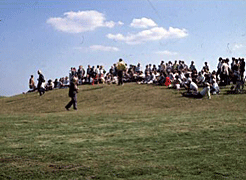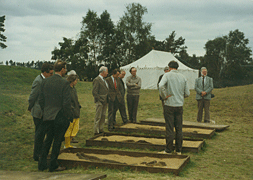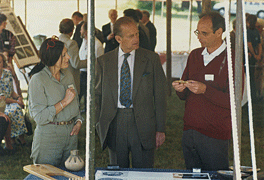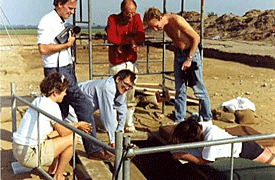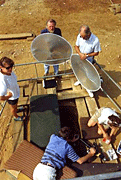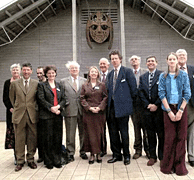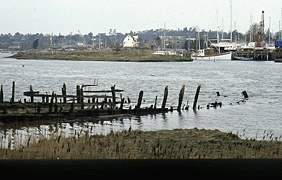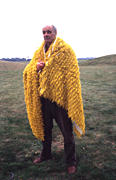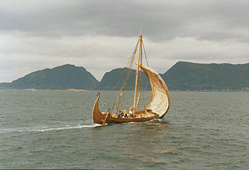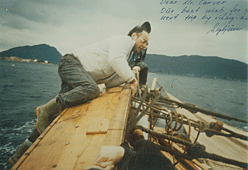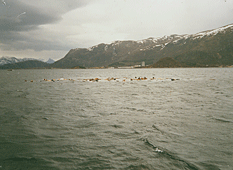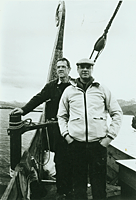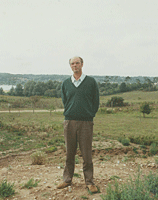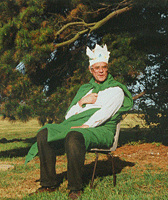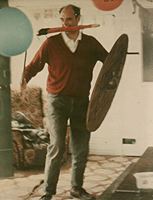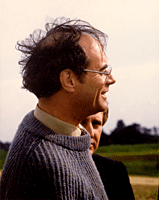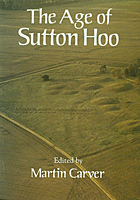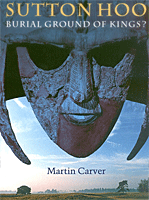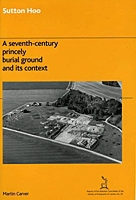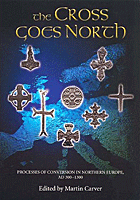Sutton Hoo
Excavating Sutton Hoo
Martin's apprenticeship in urban archaeology and in European field archaeology led to a prestigious, and challenging, task: to place Sutton Hoo in context, a research project initiated by the Society of Antiquaries of London and the British Museum in partnership with the BBC and the National Maritime Museum, formed into a Research Committee and a Research Trust (some members shown here at King's Manor in York on completion of the draft research report in 1997).
The Research Committee's approach to the project was to turn the application process into an open competition, whose core was the formulation of a research design. Martin felt extremely honoured to have his ideas about evaluation and implementation endorsed, and subsequently supported through thick and thin by the Committee and Trust. Started from Birmingham in 1983, the project moved to York in 1986, with the Department's full support for post-excavation until 1997 and publication of the research report in 2005 with deposition of the archive with ADS at York.
Leslie Webster (first on the left in the group photograph above) was a member of the Sutton Hoo Research Trust right from the start. She writes:
"The Society of Antiquaries Council Room is a deep mahogany, gloomy venue that can be rather lowering to the spirits on a dark day, and so it certainly felt back in 1982 when members of the Sutton Hoo Research Trust met to interview candidates to lead the much-debated and, at that time, somewhat controversial Sutton Hoo Project. Our task was to find a multi-faceted paragon to direct the project - a brilliant field archaeologist who would combine vision, energy and determination with the leadership skills of a tank commander, an expert in early medieval cultural history, a fund-raising genius with a shameless talent for publicity, and an all-round intellectual who could at the drop of a hat quote Pushkin in the original or burst into a snatch of Schubert. The spirits sank dismally at the scale of the challenge. But when Martin swung through the doors exuding that irrepressible mixture of confidence, authority and exuberance, the room seemed to brighten instantly - I rarely remember enjoying the process of interview so much, and well before its end we knew we had our man.
His skills were to be tested many times in the decade that followed, in keeping not just the watchful Trust but the larger Sutton Hoo Research Committee happy, and in satisfying those critics of the Project who were waiting to pounce. Martin's research design was a clever, sensitive and supple approach to the site, and in those early years he soon won over doubters, myself included. When he wasn't excavating, he threw himself energetically into TV programmes, conferences and publications, all helping to engage the scholarly and popular communities and to spread the word. Fund-raising, however, remained a recurrent concern as costs rose, and institutional budgets shrank; and as the excavation rolled onwards to the final pyrotechnics of the Mound 17 horse-burial, the need to secure the site in perpetuity and to find an appropriate way of presenting it to the public occupied a considerable amount of his energies. These are stories told elsewhere; but the monument as it is now, safely and imaginatively preserved in the hands of the National Trust, together with its excellent Visitor Centre, is a tremendous tribute to Martin's vision and hard work.
His subsequent projects - especially the Tarbat excavations, and rethinking Antiquity - have been equally starry, a testament to a brilliantly enquiring mind. But for me, Martin will always be the king of Sutton Hoo, striding across the mounds, his arms waving in unquenchable enthusiasm as he expounded his latest theories, generous in the sharing of ideas as in his formidable hospitality. But this is no obituary! - long may Martin keep on working, striding, waving and generating fun and ideas for years to come."
LESLIE WEBSTER
The Sutton Hoo research project was of course a large piece of fieldwork, and memories of 10 years' digging are plentiful, some recalled here. But it also coalesced Martin's thinking on ideology and allegiance (see bibliography below). Rosemary Cramp pays this generous tribute:
"What has always impressed me about Martin, and continues to impress me, is that to any project or problem that engages him he brings an entirely new perspective. Moreover he has the gift of sharing the developments in his thinking as they proceed to new conclusions. This was particularly effective in his site analysis of Sutton Hoo: by the time he had finished his remarkable excavation, he had introduced the archaeological world to new means of site analysis, exposing his project at each stage to comment and debate, and finally providing the famous burial mounds with a long term context such as could not have been previously imagined.
His work at Tarbat / Portmahomack was conducted in the same way and has provided new insights into the rise and fall of an ecclesiastical community, as well as a sequence of activities which uniquely add to the sum of knowledge of these complex Early Medieval sites. I have learnt a great deal from his work, and hope I can continue to do so."
ROSEMARY CRAMP
The new Sutton Hoo project marked the passage from the 'old' archaeology to the 'new' in the early 1980s. Martin was fortunate to make the link between the two, encountering such prominent figure as Christopher Hawkes (who thanked him for talking so much), Charles Phllips and Norman Scarfe, or Rupert Bruce-Mitford, shown in these photographs (sadly there is no image of Christopher Hawkes on site). The encounter with the 'new' is perhaps best encapsulated by a visit by Ian Hodder and Christine Hastorf; the last picture invites a caption competition.
Jenny Glazebrook, administrator of the Sutton Hoo Project throughout and now Managing Editor of East Anglian Archaeology, captures life on site so well in this contribution. She writes:
"It was challenging, it was hard work but above all, fun. The strongest memories are of people: communal meals in the marquee, the all-important tea breaks [here in 1984, showing, from left to right, Jenny Glazebrook, Andy Copp, Cathy Royle, Niall Oakey, Martin (photo, Nigel Macbeth)] impromptu parties by the camp fire; our august director buzzing around Sutton Hoo on a battered Garelli moped two sizes too small [photographed here by Nigel Macbeth in 1986], the hole in the seat of his cavalry twill trousers patched with a charming floral fabric; children ... more children.
There was a constant stream of visitors, many of whom were taken on site tours [here photographed by Tuija Rankama in 1985] and these were delivered by Martin with the same infectious enthusiasm whether to an audience of fresh-faced volunteers, Society of Antiquaries fellows, the Sutton Hoo Research Trust, royalty, or two elderly ladies and their poodle.
Working with Martin involved vital instructions delivered as illegible handwritten notes, cigarette ash over the telephone, red wine rings on the desk, an ancient and uncomfortable-looking camp-bed in the corner of the office (for afternoon siestas, almost never achieved). Constant challenges set the pace - one always seemed to be running to keep up. Martin's most energetic days were characterised by new ideas, methodological approaches and plans, prompting a flurry of early morning activity and the (slightly grumpy) remark among site staff: he's probably written an article already, before breakfast!
Hard work yes, but great fun too. Martin and Madeleine's warm hospitality did much to strengthen team spirit, and won them many friends. This picture was taken during the end-of-dig party at Castle Farm - it could just as easily have been Stafford, or Sutton Hoo. Martin may have been entertaining us with his gutsy rendition of Hard-hearted Hannah (all seven verses), or leading the chorus of Only Archaeology (can reveal the truth). Someone who can do this after a long day pushing the frontiers of archaeological theory and practice deserves our utmost respect and admiration."
JENNY GLAZEBROOK
Amongst Jenny's numerous tasks was the organisation of the annual field school, which welcomed many York students. Some may have come reluctantly, but for some it marked a turning point. Justin Garner-Lahire writes:
"My arrival at Sutton Hoo in the summer of 1989 was not through choice, I had simply failed to apply in time for one of the 'less serious' York excavation projects which were more popular with York undergraduates. Being one of the Department's least academically motivated students, Martin struggled to hide his disappointment on my arrival on site. There followed a week of hard physical work ranging from spoilheap management, digging pipe trenches, building sieving platforms, and cutting turf. My abiding memory from my first week at Sutton Hoo was lying down, red-faced, sweaty and exhausted, outside the kitchen having missed tea-break in order to cut turf ahead of a machine, only to be told off by Von Copp the site supervisor for 'lying down on the job', and ordered back onto site. Having survived the first week, I was allowed on site. Although I had previously worked on a number of excavation projects, Sutton Hoo was a real eye-opener. From then on I was hooked on field archaeology, and have greatly benefited from Martin's support, guidance and enthusiasm ever since."
JUSTIN GARNER-LAHIRE
Many excavators have contributed to the Sutton Hoo story, amongst them Sally Foster, now of Historic Scotland and editor of Medieval Archaeology, seen here pulling a face at Martin during the excavation of the eastern execution cemetery in 1985-6.
Sally Foster writes to accompany this photograph of Martin striding across the site:
"Martin's achievements in terms of understanding and promoting (medieval) archaeology and his pioneering approaches to fieldwork speak eloquently for themselves. What it rather difficult to find a picture to encapsulate is his inspiring enthusiasm for the subject, and the encouragement and friendly (but purposeful) steer he so effortlessly gives others. He has the rare quality of always putting a spring back in your step."
SALLY FOSTER
The excavation of Mound 17 with its rich male burial and accompanying horse burial, ploughed out and thus having escaped robbing, was amongst the highlights of 1991. Annette Roe who excavated it recalls:
"Although living in Italy, I decided to take up the invitation to help out at Sutton Hoo and came back for the last three summer campaigns. In the final summer, Martin gave me the most amazing opportunity of my career when I excavated the intact grave of the prince under Mound 17. The recording system, adapted for the purpose with naturalistic colour planning and remote mapping which avoided damage to the grave, allowed us to see the grave in 3D tracing the form of organic objects and eventually to reconstruct the sequence of the furnishing of the grave. Martin worked closely with me throughout the summer, discussing the interpretation of shapes and soil stains as they emerged, and, as autumn approached, making conditions difficult and available daylight limited, he excavated the final array of the body and grave goods as I recorded from the edge of the grave cut. This was a great team effort with people helping to sieve and survey, Peter Berry building a scaffolding 'cradle' to prevent me having to stand in the grave, and everyone working early to open up the covers or late to help clear up for Nigel MacBeth to take photographs. It was a hard summer, but so enjoyable and a great chance to work with Martin and benefit from his knowledge, his ready ideas and his enthusiasm. This is how archaeology should be."
ANNETTE ROE
Digging at Sutton Hoo was a privilege. It was felt by all involved in the project, and promoted by Martin's ability to build up a team, for example in regular Friday afternoon site tours. For a while, Sutton Hoo was life, with children or Russian and Moldovan visitors, egos and all.
Sally Foster, who sent this photograph of Martin with Freddie in 1986, writes:
"This picture finds us on what I remember as the turkey farm, where the Sutton Hoo diggers camped out in converted barns in 1986. While I can't recollect the cause for celebration and party hats, it captures nicely Martin's capacity for hard work underpinned by fun for his real family, as well as seasonally adopted family of diggers. And for those of us who have worked with him over the years, or made an occasional pilgrimage to his excavations, the pleasure of watching Freddy et al growing up."
SALLY FOSTER
Work and family were indeed closely connected, and, at Sutton Hoo and elsewhere, Martin inspired his children. Gevi Carver writes:
"Dad,
I think archaeology is the most interesting subject there is, and it's all because of you. Not that I was ever pushed to think that; I think it because you've shown me. And, yes, you've done that in a 'fatherly' way, but I bet there are a lot of people who feel the same. Undoubtedly some of them have been inspired by your academic work, but I have to admit I'd never read a word you'd published until last year...! I, along with countless diggers around the campfire at Sutton Hoo, local fishermen in the Castle Inn, Portmahomack, students in the corridor of King's Manor and many others, have become a Martin Carver convert to archaeology by talking to you. I don't know when it happened - in the pissing down rain as our tent was nearly blown off a cliff in Orkney, maybe, or when the family ex-departmental minibus got stuck in a snow drift in the French Alps - but at some point, listening and speaking to you, I got it. I understood that the whole of the human past was one big conversation, and by opening that up you could continue the conversation and speak not only to everybody in the world, but to everybody who has ever been in it. And that, for a Carver, was too good to be missed."GEVI CARVER
Amongst the many tasks incumbent on a research director was the promulgation of the project to everyone, in the academic forum, in public lectures, on site visits and on television (here some scenes from these ventures) and above all working to secure the long-term future of the Sutton Hoo site. This was resolved by the generous gift by Annie Tranmer of the Sutton Hoo estate to the National Trust and the Trust's building of the Sutton Hoo visitor centre, opened by Seamus Heaney in 2002.
Angus Wainwright, National Trust archaeologist responsible for Sutton Hoo, writes:
"This is Martin reluctantly wrapped not in an oversized bathmat but in a unique re-creation of a seventh-century looped-pile cloak from Sutton Hoo Mound 1, made for the National Trust's visitor centre there. Angus Wainwright, the Trust's archaeologist for the East of England, was one of those responsible for creating the exhibition. "Martin is both the supreme expert on Sutton Hoo and absolutely committed to interpreting archaeology to a non-specialist audience. But we also knew that, in creating the exhibition for the site, we were enjoying doing what he had always wanted to do. Despite this, he was incredibly generous with his time and ideas, not only briefing us on technical and academic matters but also anticipating the practical problems of communicating to a varied audience. Martin, thank you for your imagination, your pragmatism and your utter lack of vanity."
ANGUS WAINWRIGHT
Filming by the BBC, for BBC2's Chronicle programmes, produced by Ray Sutcliffe, led to adventures beyond the North Sea. The incident in Norway, where the BBC was filming the sailing trial of the full scale replica of the Oseberg ship the Edda has often been told in Martin's public lectures. Here it is retold in pictures:
And finally, Martin at Sutton Hoo in different guises:
References to Sutton Hoo excavations (MOHC bibliography)
- 1983. The Sutton Hoo Research Project: research design, 3rd revision (1 April 1983). Bulletin of the Sutton Hoo Research Committee 1: 1-17.
- 1983. Sutton Hoo: detailed research proposals. Rescue News 31 (Autumn 1983): 2-5.
- 1984 (ed.). Bulletin of the Sutton Hoo Research Committee 2.
- 1985. Anglo-Saxon objectives at Sutton Hoo. Anglo-Saxon England 15: 139-52.
- 1985. Sutton Hoo. Current Archaeology 95: 358-60.
- 1985. Confronting the past through new technology. The Listener 29 August: 13-14.
- 1985. Sutton Hoo: management and intervention on acid sandy sites, in ICCROM Conference, Ghent: 27-44.
- 1985 (ed.). Bulletin of the Sutton Hoo Research Committee 3.
- 1986. Sutton Hoo in context. Settimane di Studio del Centro Italiano di Studii sull' alto medioevo 32: 77-123. Spoleto.
- 1986 (ed.). Bulletin of the Sutton Hoo Research Committee 4.
- 1986. The 'ploughman', the 'hanged man' and the cult of Woden. Saxon (Sutton Hoo Society journal).
- 1987. Graphic recording at Sutton Hoo: single instrument remote plotting - with no strings attached. The Field Archaeologist 7: 102-3.
- 1987 (with P. Bethell). Detection and enhancement of decayed inhumations at Sutton Hoo, in A. Boddington, A.N. Garland & R.C. Janaway (ed.) Death, decay and reconstruction: 10-21. Manchester: Manchester University Press.
- 1988 (ed.). Bulletin of the Sutton Hoo Research Committee 5.
- 1989. Kingship and material culture in Early Anglo-Saxon East Anglia, in S. Bassett (ed.) The origins of the Anglo-Saxon kingdoms: 141-58. Leicester: Leicester University Press.
- 1989. Anglo-Saxon discoveries at Sutton Hoo, 1987-1988. Old English Newsletter 22.2.
- 1989 (ed.). Bulletin of the Sutton Hoo Research Committee 6.
- 1984-1989 (ed. & presented). TV documentaries on Sutton Hoo for BBC2 (50 min each): New Beginnings, The last of the Pagans and Sea Peoples.
- 1990. Pre-Viking traffic in the North Sea, in S. McGrail (ed.) Maritime Celts, Frisians and Saxons: papers presented to a conference at Oxford in November 1988 (CBA Research Report 71): 117-125. London: Council for British Archaeology.
- 1990 (ed.). Bulletin of the Sutton Hoo Research Committee 7.
- 1992 (ed). The Age of Sutton Hoo: the seventh century in north-western Europe. Woodbridge: Boydell & Brewer (reprinted 1994).
- 1992. The Anglo-Saxon cemetery at Sutton Hoo - an interim report, in M.O.H. Carver (ed.) The Age of Sutton Hoo: the seventh century in north-western Europe: 343-71.
- 1992. The future of Sutton Hoo, in C.B. Kendall & P.S. Wells (ed.) Voyage to the other world: the legacy of Sutton Hoo: 183-200. Minneapolis: University of Minnesota Press.
- 1992 (with A. Selkirk). Sutton Hoo: a drama in three acts. Current Archaeology 128: 324-30.
- 1993. Sutton Hoo: the graveyard of Anglo-Saxon pagan kingship. Minerva 4(4): 28-33.
- 1993 (ed.). Bulletin of the Sutton Hoo Research Committee 8.
- 1993 (ed). The Sutton Hoo Research Committee Bulletins 1983-1993 (omnibus edition). Woodbridge: Boydell.
- 1996? Sutton Hoo, in Lexicon des Mittelalters. Zürich.
- 1996? Sutton Hoo, in Reader's Digest Family Encyclopaedia of World History.
- 1997? Theatre of death, in British Heritage. Harrisburg (PA).
- 1997. Immemorial mounds. National Trust Magazine.
- 1998. Sutton Hoo: burial ground of kings? London: British Museum Press (reprinted 2000, 2005) (1999 Runner up BAA Book of the Year).
- 1998. On - an off - the Edda, in O. Olsen, J.S. Madsen & Fi. Riek (ed.) Shipshape: essays for Ole Crumlin-Pedersen on the occasion of his 60th anniversary, February 24th 1995. Roskilde: Vikingeskibshallen.
- 1999. Cemetery and society at Sutton Hoo; five awkward questions and four contradictory answers, in C.E. Karkov, K. Wickham-Crawley & B.K Young (ed.) Spaces of the living and the dead: an archaeological dialogue (American Early Medieval Studies 3): 1-14. Oxford: Oxbow.
- 1999. Exploring, explaining, imagining: Anglo-Saxon archaeology 1998, in C.E. Karkov (ed.) The archaeology of Anglo-Saxon England: basic readings: 25-52. London & New York: Routledge/Garland.
- 1999: 'Sutton Hoo' and 'Princely burials' for M. Lapidge, J. Blair, S. Keynes & D. Scragg (ed.) Blackwell Encyclopaedia of Anglo-Saxon England: 376-8; 432-6.
- 2005. Sutton Hoo: a seventh-century princely burial ground and its context (Report of the Research Committee of the Society of Antiquaries of London 69). London: British Museum Press (2006 Runner-up, BAA Scholarly Book of the Year).
- 2005 (with A. Copp, M. Hummler & C. Royle), prepared by Kieron Niven and the support of J.D. Richards. Sutton Hoo field reports. York: Project ARchive deposited with ADS.
(http://ads.ahds.ac.uk/catalogue/projArch/suttonhoo_var_2004)
Thinking about ideology and allegiance (MOHC bibliography)
This section contains bibliographical references to publications on ideology and allegiance not already mentioned in the site-specific references to Sutton Hoo.
- 1992. Ideology and allegiance in East Anglia, in R. Farrell & C. Neuman de Vegvar (ed.) Sutton Hoo: fifty years after (American Early Medieval Studies 2): 173-82. Oxford (Ohio): Miami University.
- 1993 (ed). In Search of cult: archaeological investigations in honour of P.A. Rahtz. Woodbridge: Boydell & Brewer.
- 1995. Boat burial in Britain: ancient custom or political signal?, in O. Crumlin-Pedersen & B. Munch (ed.) The ship as symbol in prehistoric and medieval Scandinavia: 111-24. Copenhagen: National Museum of Denmark.
- 1998. Conversion and politics on the eastern seaboard of Britain: some archaeological indicators, in B. Crawford (ed.) Conversion and Christianity in the North Sea world: 11-40. St Andrews: University of St Andrews.
- 1998. Ueberlegungen zur Bedeutung angel-sächsischer Grabhügel, in A. Wesse (ed.) Studien zur Archäologie des Ostseeraumes von der Eisenzeit bis zum Mittelalter: Festschrift für Michael Müller-Wille: 259-268. Neumünster.
- 1999. Preface to H. Geake & J. Kenney (ed.) Early Deira: archaeological studies of the East Riding in the fourth to ninth centuries AD: ix-xi. Oxford: Oxbow.
- 2000. Burial as poetry: the context of treasure in Anglo-Saxon graves, in E.M. Tyler (ed.) Treasure in the Medieval West: 25-48. York & Woodbridge: York Medieval Press/ Boydell.
- 2001. Why that, why there, why then? The politics of early medieval monumentality, in A. MacGregor & H. Hamerow (ed.) Image and power in early medieval British archaeology: essays in honour of Rosemary Cramp: 1-22. Oxford: Oxbow.
- 2001. Review of Simon Taylor (ed.) Kings, Clerics and Chronicles in Scotland, 500-1297: essays in honour of Marjorie Olgivie Anderson on the occasion of her ninetieth birthday, in English Historical Review 468: 921-2.
- 2002. Marriages of true minds: archaeology with texts, in B. Cunliffe, W. Davies & C. Renfrew (ed.) Archaeology: the widening debate: 465-96. British Academy (2004: Tvier hjartans vinir. Fornleifafraeði og textar Ritið 2: 215-57 translation of above into Icelandic).
- 2002. Reflections on the meaning of Anglo-Saxon barrows, in S. Lucy & A. Reynolds (ed.) Burial in Early Medieval England and Wales (Society for Medieval Archaeology Monograph 17): 132-43. London: Society for Medieval Archaeology.
- 2002. Politik und Kultur im Britannien des 10. Jahrhunderts, in J. Henning (ed.) Europa im 10. Jahrhundert: Archäologie einer Aufbruchszeit: 209-226. Mainz: Philipp von Zabern.
- 2003 (ed.). The Cross goes North: processes of Christian conversion in northern Europe, AD 300-1300. York & Woodbridge: York Medieval Press/Boydell (2006 paperback edition).
- 2003. Introduction: northern Europeans negotiate their future, in M.O.H. Carver (ed.) The Cross goes North: processes of Christian conversion in northern Europe, AD 300-1300: 3-13. York & Woodbridge: York Medieval Press/Boydell.
- 2003. Britain, ideologies and the Frisian Sea, in W. Groenman-van Waateringe, B. van Beek & W. Metz (ed.) Het Instituut: vijftig jaar: 68-79. Amsterdam: Amsterdams Archeologisch Centrum Institut voor Prae-en Protohistorie.
- 2008. Archaeology, monasticism and Romanitas in northern Britain (review article). Antiquity 82: 220-22.
- In press 2008. Politics and territories in Anglo-Saxon England, in H. Hamerow & D. Hinton (ed.) Anglo-Saxon Handbook. Oxford: Oxford University Press.
- Forthcoming. On reading Anglo-Saxon graves (J.M. Kemble lecture for 2008). To be published by Trinity College Dublin. Forthcoming. Ancestral airs, in The Aldborough Anthology.
- Forthcoming. Contributions to The Oxford Dictionary of the Middle Ages, Marymount Encyclopaedia.
- In prep. Early Medieval Britain .Blackwells
